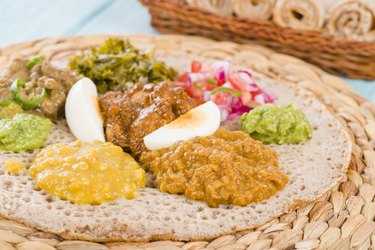
Ethiopian cuisine is delicious and boasts numerous health benefits, but it starts with an appetizing aroma of spices and inviting colorful dishes.
Ethiopian food is often served over injera, a spongy, sourdough-like flatbread that resembles a pancake and is made from teff flour, a gluten-free ancient grain that's indigenous to the Ethiopian highlands, says Wintana Kiros, RDN and founder of The Reset Lifestyle.
Video of the Day
Video of the Day
Ethiopian cuisine is unique to the country and shares dishes with neighboring Eritrea. In addition to using international seasonings such as fenugreek, garlic, coriander, cloves, turmeric, nigella and cinnamon, traditional Ethiopian cuisine boasts an array of local spices.
Ethiopian Spices and Flavors
In his book Ethiopia: Recipes and Traditions from the Horn of Africa, Chef Yohanis Gebreyesus shares that korerima, koseret and besobela are some of the most commonly used spices.
Korerima looks like cumin but tastes more like green cardamom. Koseret, an herb from the verbena family, imparts a flavor similar to oregano. Besobela, also known as Ethiopian basil, harbors a flavor much like Thai basil.
All these herbs and spices are combined in colorful, mild to extra spicy seasoning blends.
Tip
Kiros says you can usually tell the flavor of a seasoning by the color: “The spicy sauces are red or brownish, almost warning you of their heat.” The yellow blends are milder and packed with flavors like turmeric, garlic and ginger.”
At the core of Ethiopian cuisine are nitter kibbeh and berbere. Nitter kibbeh, a clarified butter seasoned with herbs such as nigella seeds, cardamom, dried koreset (substitute green cardamom) and besobella (substitute Thai basil) is described by Chef Gebreyesus as the flavor that makes Ethiopian food recognizable.
Kiros equates berbere as essential in Ethiopian cooking as curry powder is to many Indian dishes. A pungent, earthy spice blend, berbere's red color is a telltale sign of its heat from dried red-hot peppers. In addition to hot peppers, berbere may contain coriander, fenugreek, ginger, besobela and cinnamon.
Ethiopian cuisine is not all heat. Erd — made from turmeric, cumin, garlic and coriander — seasons mild dishes while Awaze — a dipping sauce made from mixing berbere and tej, a fermented honey wine — balances heat with a little sweetness.
Common Ethiopian Foods and Dishes
- Injera: Often doubling as both a plate and utensil, injera is one of Ethiopia's most-consumed starches and sometimes served at all meals.
- Wot: A spicy sauce or stew akin to curry and often seasoned with berbere. Popular wots include doro wot, a chicken stew with boiled egg; yemisir wot, a lentil stew; shiro wot, a ground chickpea dish with a consistency of hummus; and atakilt wot, which has spiced cabbage, carrots and tomatoes.
- Tibs: Fried pieces of meat seasoned with berbere or milder seasoning mixes. Tibs are sometimes mixed with onions and jalapenos. Common tib dishes include beef, chicken and lamb.
- Gomman: Collard greens sautéed in onions and oil.
- Kifto: Ground raw beef seasoned with nitter kibbeh (spiced clarified butter).
- Yetsom Beyayneta: Vegan curries served on top of injera and usually enjoyed on Wednesdays and Fridays, which are fast days for Ethiopian Orthodox Christians.
- Coffee: Ethiopia is the birthplace of coffee and the beverage is celebrated with elaborate coffee ceremonies.
Health Benefits of Ethiopian Food
1. It Can Be Plant-Based
About 43 percent of Ethiopians are Orthodox Christians, per the Pew Research Center, and due to religious reasons abstain from meat and dairy during the 180 to 250 fasting days of the year.
Plant-based diets (or flexitarian diets) are linked to a lower risk of death, especially heart disease-related deaths, according to an August 2019 correlative study in JAMA Internal Medicine.
Eating more legumes, an Ethiopian food staple, may help lower LDL cholesterol levels and improve heart health.
2. It's High in Fiber
Ethiopian staples such as teff and lentils are great sources of fiber.
Diets high in fiber are associated with a decreased incidence of chronic disease such as type 2 diabetes, heart disease and some forms of cancer. Fiber may also assist with weight management by slowing digestion and increasing satiety, per the Mayo Clinic.
3. It's Rich in Antioxidants
A September 2017 review in Antioxidants supports a strong body of evidence that spices can reduce or eliminate the harmful effects from contaminants in food and the environment thanks to their antioxidant content.
Ethiopian food is flavored with an array of herbs and spices that are linked to fighting inflammation and disease. For example, the Antioxidants review indicates that curcumin (found in turmeric) has antioxidant and anti-inflammatory properties, which may decrease triglycerides and cholesterol.
Hot peppers used to make spice blends such as berbere are rich in capsaicin — an antioxidant that gives hot peppers their heat. Capsaicin may improve blood sugars and lower cholesterol levels.
- Pew Research Center: "Ethiopia is an outlier in the Orthodox Christian World"
- Nutrients: "Dietary Fiber, Gut Microbiota, and Metabolic Regulation-Current Status in Human Randomized Trials"
- Antioxidants: "Antioxidant Activity of Spices and Their Impact on Human Health. A Review."
- Nutrients: "Capsaicin in Metabolic Syndrome"
- Mayo Clinic: "Dietary fiber: Essential for a healthy diet"